The cerebellum as a whole has afferent connections (input) and efferent connections (output). Within the cerebellar cortex, ongoing circuits driven by cerebellar input define cerebellar output. Based on comparisons of intended motion with actual perfomance, cerebellar output modifies activity in motor centers to correct detected errors of movement.
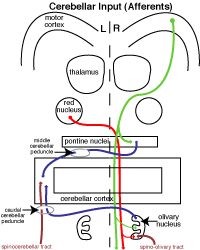
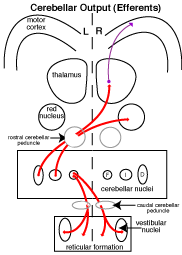
Cerebellar afferents (input):
Afferent axons to the cerebellum are excitatory. The axons send collateral branches to cerebellar nuclei before terminating in cerebellar cortex. The afferents generally excite neurons in cerebellar nuclei and, via cortical circuits, selectively excite Purkinje neurons in cerebellar cortex. Cerebellar afferents include:
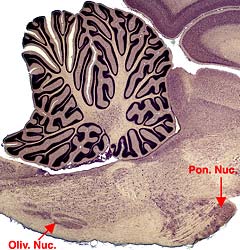
mossy fibers:
• from vestibular nuclei & vestibular nerves
• from multiple spinocerebellar tracts
• from motor-related cerebral cortex,
via pontine nuclei
climbing fibers:
• from the contralateral olivary nucleus
Cerebellar cortex circuitry:
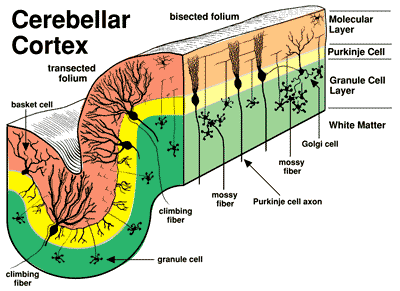
Mossy fibers excite granule cells, whose axons enter the molecular layer and bifurcate into parallel fibers that run longitudinally in a folium. The parallel fibers excite bands of Purkinje cells and basket cells, the latter inhibit Purkinje cells along the edges of the excited band. Climbing fibers excite individual Purkinje cells to fire action potentials repetitively.
Axons of selectively excited Purkinje cells inhibit selected neurons within cerebellar nuclei (or within vestibular nuclei in the case of the flocculonodular lobe).
Cerebellar efferents (output):
Cerebellar output consists of axons from neurons within cerebellar nuclei (or cerebellar cortex of the flocculonodular lobe). The axons synapse on neurons in brainstem motor centers or in thalamic nuclei that project to motor-related cerebral cortex. Thus the cerebellum modifies ongoing posture and movement by means of selective patterns of excitatory drive from the cerebellum to movement centers.
Spinocerebellar Pathways
To regulate movement properly, the cerebellum needs proprioceptive input from muscles and joints (plus some tactile input). This input is delivered to the cerebellum via different spinocerebellar tracts. In the head, the trigeminal nerve (trigeminal mesencephalic nucleus) conveys proprioception to the cerebellum.

Spinocerebellar tracts:
• The dorsal spinocerebellar tract arises from projections neurons in the nucleus thoracicus, located in the thoracolumbar spinal cord. The tract conveys proprioception from the caudal half of the body and reaches the cerebellum via the caudal cerebellar peduncle.
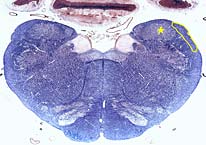 • Proprioception from the thoracic limb and neck travels in the fasciculus cuneatus to the lateral cuneate nucleus. The nucleus contains projection neurons. Their axons run to the cerebellum through the caudal cerebellar peduncle.
• Proprioception from the thoracic limb and neck travels in the fasciculus cuneatus to the lateral cuneate nucleus. The nucleus contains projection neurons. Their axons run to the cerebellum through the caudal cerebellar peduncle.
• A ventral spinocerebellar tract originates from nucleus proprius throughout the spinal cord. Axons decussate in the spinal cord, run in the lateral funiculus, and reach the cerebellum via the rostral cerebellar peduncle. Within the cerebellum the axons decussate again, so the spinal input is ultimately ipsilateral.